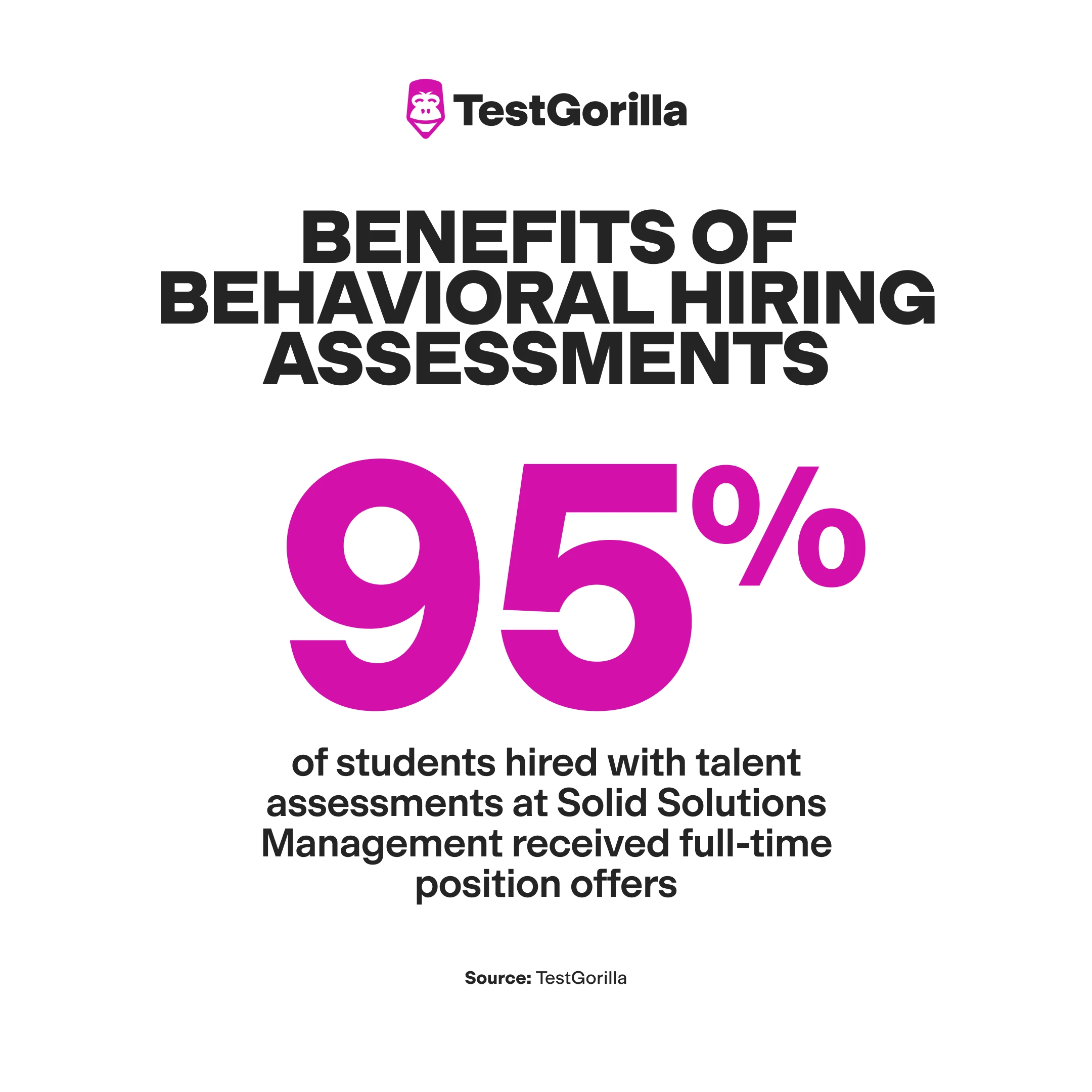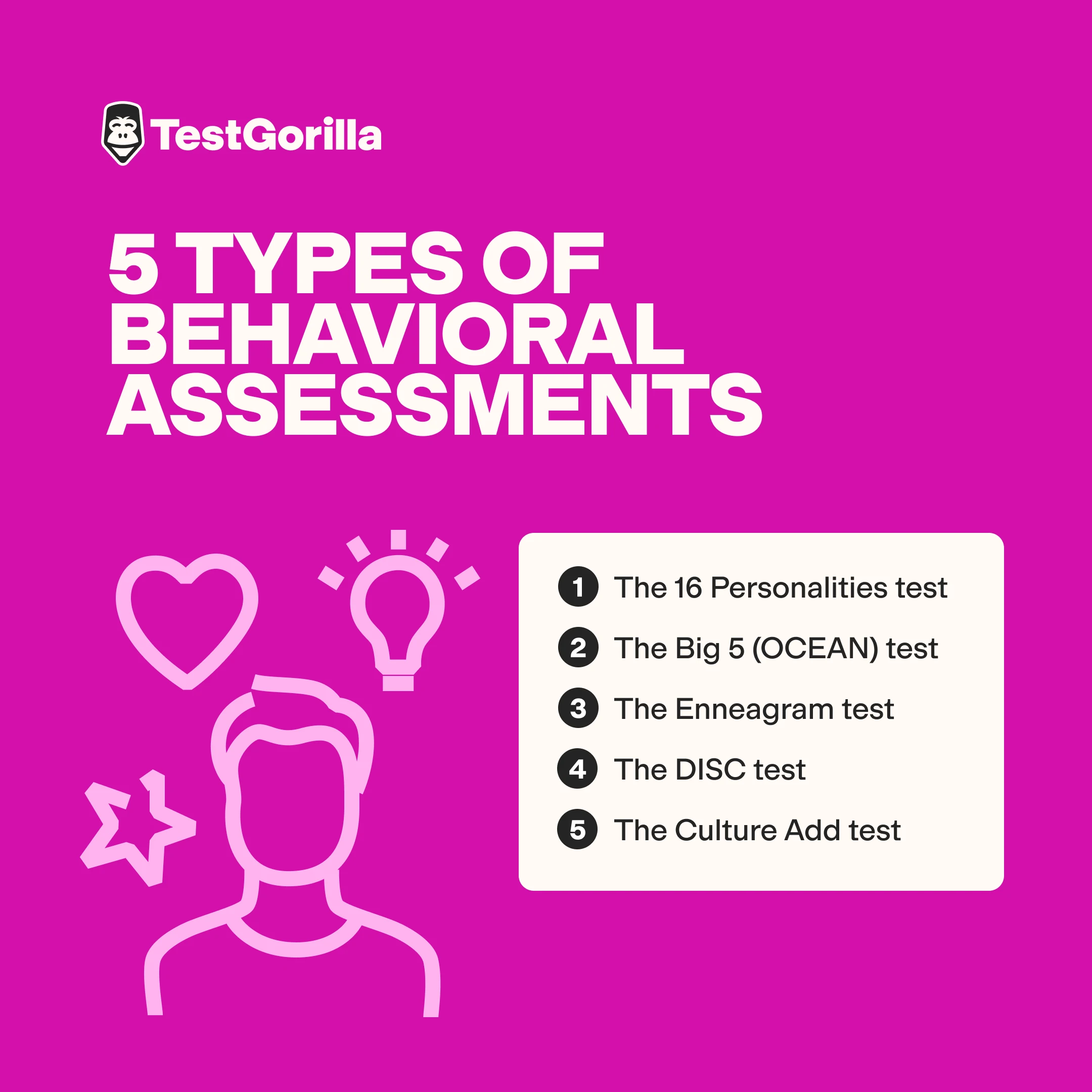Behavioral assessments for hiring: The complete guide
Discover top talent by using behavioral assessments
When you make hiring decisions, can you predict how well someone performs on the job?
Unfortunately, it’s tough to guess a candidate’s behavior based only on resumes and interviews. Much of what you learn about their personality doesn’t come until you see them in action.
Behavioral assessments get you those answers sooner rather than later by testing candidates on their underlying traits.
This article explores how behavioral testing improves recruitment and provides an overview of the most effective behavioral assessments for hiring.
Table of contents
What is a behavioral assessment?
Behavioral assessments examine a candidate’s personality traits, motivations, and behavioral habits to predict their likelihood of job success. Psychologists, behavioral analysts, and data scientists design these tests to predict how candidates act in different situations based on their reactions. The tests ask candidates about their likes, dislikes, aspirations, fears, abilities, and challenges and map them to ideal workplace situations.
For example, a candidate who enjoys a predictable routine is going to be far more suited to an administrative role than a candidate who thrives on constant change.
Assessment tools can identify adaptive behavior in many instances, including in individuals with disabilities. Rating scales also evaluate a problem behavior to improve mental health issues like autism.
For a deep dive into the science behind behavior testing, check out our science intro to behavioral competencies.
How to use behavioral assessments
Recruiting teams typically give behavioral hiring assessments to human resources during the screening process. These psychometric assessments are normally combined with other talent assessments to provide a well-rounded view of each candidate.
Some employers include this skills-based hiring method in the initial application to screen candidates, but most send it to a limited number of prescreened candidates before the interview stage as an additional method of comparing candidates.
Behavioral assessments for hiring
Using a behavioral assessment test for employment has a lot of potential:
Screens and shortlists candidates based on their behavior and attitude
Determines whether candidate values and preferences align with your business
Gives you a detailed and accurate view of the applicant’s traits before making a decision
Our talent assessments, which gauge hard and soft skills, increase the knowledge you gain about your candidate during a behavioral interview and are the optimal tool to replace resume screening.
Using a variety of tests, including a behavioral assessment for employment, gives you a holistic view of the candidate, including their role-specific skills and cultural alignment.
See how talent assessments fit into the ideal hiring process in our product tour.
Behavioral assessments for learning and development
What is a behavioral assessment’s role in learning and development? Behavioral testing is an excellent method to review your employees’ values and help them work toward their career goals.
Employee behavior assessments help you discover employees’ behavioral traits and factor them in when discussing career progression.
For example, an Enneagram test shows that an employee is a Type 1 – purposeful and idealistic, with a strong moral compass. They’re great leadership material, apart from impatient tendencies.
You can now create a training program to help your team members develop important leadership traits like patience and compromise.
Benefits of behavioral hiring assessments
Testing behavior competencies shows a candidate’s potential to develop, grow, and work well in a team.
Candidates hired for personality traits like emotional intelligence and teamwork are powerful additions to a team. Experts agree that if these hires aren’t proficient in certain hard skills, they can be quickly upskilled – but you can’t train attitude.
Solid Solutions Management uses our DISC test, a work-related behavior test, to discover vital personality traits and train candidates in any missing technical skills. This strategy works: 95% of students hired with talent assessments received full-time position offers
Behavioral assessments for hiring also enabled AMC Theatres to reduce turnover, improve their work environment, and increase employee engagement and customer satisfaction.
Here are six compelling reasons to include behavioral tests as part of your hiring process:
Benefit | Description |
1. Predicts employee job performance | Using multiple different assessment methods can result in a strong predictor of job success, including cognitive ability and behavioral assessment tests |
2. Predicts behavior through personality | Personality is a better predictor of future behavior than a person’s past on-the-job behavior in other roles |
3. Prompts honest answers | Behavioral tests ask multiple-choice questions with equally respectable answers. The goal is to match the right traits with the right roles, not classify certain traits as good and other traits as bad |
4. Reduces hiring bias and increases objectivity | Standardized behavioral assessments help you compare personality traits objectively without considering the candidate’s race, gender, or age |
5. Increases cultural alignment | Behavioral assessments help you hire employees who share your values and align with your company’s mission |
6. Improves time-to-hire | Behavioral tests can cut administrative and processing times by 50% to 75% |
Employee behavioral assessment: Limitations and considerations
The benefits of behavioral hiring assessments outweigh their disadvantages, but they do come with limitations:
Behavior tests don’t give the full picture of a candidate, so you shouldn’t rely solely on them
While taking the test, a candidate can be nervous and give answers that don’t accurately reflect their actual behavior
A candidate could give false answers based on their research into your company to create a positive impression
Relying solely on personality tests is detrimental. Always incorporate them into multi-measure assessments, gauging role-specific abilities and soft skills.
It’s also important to remember that if someone doesn’t possess the desired skills and traits but shows potential, they can learn a lot on the job and develop their character traits.
5 types of behavioral assessments
Now, let’s take a quick look at five different types of behavioral assessments.
For in-depth insights, read our full guide to personality tests.
1. The 16 Personalities test
The 16 Personalities test is a questionnaire where candidates describe how they process information, what drives their decision-making, and how they live their lives.
The 16 Types test is similar to the Myers Briggs Type Indicator (MBTI), a test based on the work of Carl Jung, a Swiss psychiatrist. It is a common employee behavioral assessment, with 89 of the Fortune 100 companies gauging hires with MBTI tests.
This talent assessment takes an introspective approach, asking candidates a series of questions about their own perceptions. It asks candidates to self-reflect on four different dimensions, each given as a spectrum:
Introversion (I) | Extroversion (E) |
Intuition (N) | Sensing (S) |
Feeling (F) | Thinking (T) |
Judging (J) | Perceiving (P) |
A candidate’s result is given as a four-letter combination, such as iNtj or Estp, where the capital letter emphasizes the candidate’s strongest personality element.
This data helps you prepare targeted interview questions and gives insight into how people may add to your team.
2. The Big 5 (OCEAN) test
The Big 5 test, also known as the OCEAN test, is derived from the five-factor model (FFM) theory that splits personality into five dimensions.
OCEAN is an acronym for the five personality dimensions the test assesses:
Openness
Conscientiousness
Extroversion
Agreeableness
Neuroticism
Each personality trait sits on a spectrum. For example, “openness” is a range between inventive and curious and consistent and cautious.
The test asks candidates to self-report by scoring themselves on a scale from 1 (very inaccurate) to 5 (very accurate) on a series of statements about their behavior and personality, such as:
I feel little concern for others.
I am always prepared.
I get stressed out easily.
The Big 5 test gives you a more thorough understanding of the candidate’s personality traits, which can help you understand their fit for a particular role.
3. The Enneagram test
The Enneagram test distinguishes nine personality types. Based on the work of Oscar Ichazo and Claudio Naranjo, the test positions a candidate’s personality on a nine-point diagram known as an “enneagram.”
[graphic here]
This behavioral assessment for employment aims to understand someone’s core beliefs and how they relate to different people.
The Enneagram test asks candidates to choose between two statements, such as:
I rarely display signs of affection – OR – I am not afraid to display signs of affection
Friendship over fairness – OR – Fairness over friendship
I am determined in times of hardship – OR – I withdraw and am demotivated when faced with hardship
The test provides insights into the candidate’s personality, approach to personal relationships, and work style in a professional setting. It also suggests how the candidate may interact with different Enneagram types.
4. The DISC test
The DISC test asks candidates to self-evaluate on the following four dimensions:
Dominance (D
Influence (I)
Steadiness (S)
Conscientiousness (C)
Some tests treat each personality category as a spectrum. On the other hand, the DISC test positions someone as a single category (e.g., D) or as a blend of a category and one of its neighbor categories (e.g., DI or DC).
This behavioral assessment for jobs asks candidates to rate statements about their personality from “Very inaccurate” to “Very accurate.” A few examples include:
I put people under pressure.
I joke around a lot.
I hesitate to criticize other people’s ideas.
See more behavioral assessment examples by checking out our sample questions.
The DISC test provides insights into how each type is likely to behave in personal relationships and the workplace. It also describes their best traits and possible challenges.
5. The Culture Add test
The Culture Add test measures a candidate’s values and behaviors relative to your company’s values. It also enables you to learn more about candidates’ belief systems, modes of operation, and team behavior.
The test assesses candidates' values, such as achievement, equality, and independence, and behaviors, such as being analytical, diligent, or helpful.
The Culture Add test is customized to your company’s values. First, you complete a survey where you rate a list of values and behaviors as they apply to your company values.
Then, the candidate receives a survey and must self-assess the relative importance of the same values and behaviors.
This behavioral assessment test for employment shows how a candidate aligns with your organization’s values and indicates how their behaviors may enable them to succeed or fail in a particular role.
The Culture Add test lets you distance yourself from the idea of “cultural fit,” which suggests that only candidates that fit the existing culture make good hires. Hiring managers shouldn’t look for culture-fit candidates because bias is sure to enter their decision-making.
Start behavioral testing today by signing up for our Free Forever Plan.
Gauge the whole candidate with behavioral assessments
Behavioral assessment tests help you find the most suitable talent for your team. Use them with technical tests and soft skill exams to shortlist candidates who align with your organization’s values and discover areas of improvement in existing employees.
Start by registering for a Free Forever account today and gaining unlimited access to the Big 5 test.
You can learn more about behavioral testing by booking a demo with one of our talent assessment experts.
Are you interested in how talent assessments fit into the whole recruitment process? Take our product tour for more insights.
Behavioral assessment FAQs
Let’s cap off this guide by answering a few questions about behavior testing.
What is the most common behavioral assessment?
The most common employee behavior assessment is the MBTI or 16 Personalities test. It was created in the early 20th century by Katharine Cook Briggs and her daughter, Isabel Briggs Myers, as a way to simplify Carl Jung’s psychological work. The assessment measures how candidates perceive the world, get their work done, and interact with others.
What is the primary goal of behavioral assessment?
Behavioral assessments for hiring are used to evaluate a candidate’s values, cultural alignment, and attitude. They give employers important information on the candidate’s role fit, including how they interact with colleagues and whether they’re suitable for a client-facing position. Behavioral assessments give insights into a candidate’s personality, but you should never use them alone.
A functional behavioral assessment can also help in behavior intervention in special education programs or when an individualized education program is required.
What is included in a behavioral assessment?
Employee behavioral assessments consist of a series of self-evaluating questions that discover a candidate’s perception of themselves and the world. These questions typically ask how closely a person relates to a statement, and the test uses the data to discover personality traits such as extroversion, conscientiousness, and openness.
What is an example of a behavioral test?
Behavioral testing comes in various forms, including written personality assessments and structured interviews. Assessments are useful for learning a person’s traits, values, and personality, and interviews are great for prompting open-ended responses for a deep dive. Many employers use a combination of these techniques to get a holistic view of potential hires.
Related posts
Hire the best candidates with TestGorilla
Create pre-employment assessments in minutes to screen candidates, save time, and hire the best talent.
Latest posts
The best advice in pre-employment testing, in your inbox.
No spam. Unsubscribe at any time.

Hire the best. No bias. No stress.
Our screening tests identify the best candidates and make your hiring decisions faster, easier, and bias-free.
Free resources
This checklist covers key features you should look for when choosing a skills testing platform
This resource will help you develop an onboarding checklist for new hires.
How to assess your candidates' attention to detail.
Learn how to get human resources certified through HRCI or SHRM.
Learn how you can improve the level of talent at your company.
Learn how CapitalT reduced hiring bias with online skills assessments.
Learn how to make the resume process more efficient and more effective.
Improve your hiring strategy with these 7 critical recruitment metrics.
Learn how Sukhi decreased time spent reviewing resumes by 83%!
Hire more efficiently with these hacks that 99% of recruiters aren't using.
Make a business case for diversity and inclusion initiatives with this data.
























